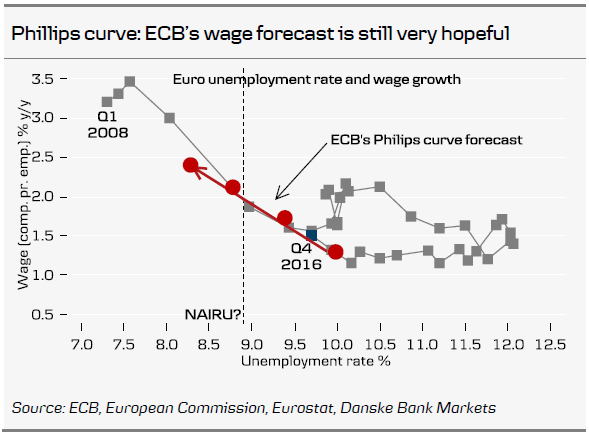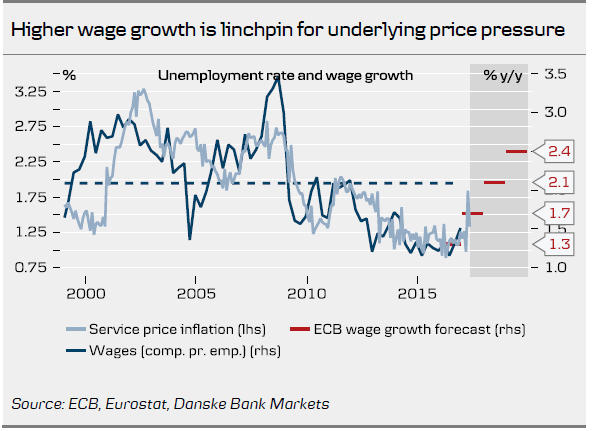The ECB kept policy rates and its QE programme unchanged but changed forward guidance on policy rates as it no longer expects these to go to ‘lower levels’. The rest of the forward guidance was left unchanged implying the ECB now expects policy rates "to remain at their present levels for an extended period of time, and well past the horizon of the net asset purchases". Regarding the QE purchases, the ECB continued to have an easing bias as it communicated that it stands ready to increase QE in terms of size and/or duration.
According to President Mario Draghi, the ECB changed its forward guidance on policy rates as the deflation risks have disappeared. However, this was despite the ECB lowering its inflation projection throughout its entire forecast horizon. In particular, the inflation forecast for 2018 was lowered to 1.3% from 1.6% previously, while the forecast for 2019 was revised down by 0.1pp to 1.6% bringing it even further away from the 2% target.
The reduced deflation risk should instead mainly reflect a stronger economic outlook. The ECB now characterises the risks to the economic outlook as ‘broadly balanced’ while it revised its GDP growth projection upwards by 0.1pp in 2017, 2018 and 2019. That said, Draghi again emphasised that the economic expansion has to feed through to prices and, while employment was increasing, he argued the ECB needs to be patient to see if the underlying price pressure picks up as many jobs are created within low quality sectors and also are part-time positions.
Crucially, Draghi said underlying inflation is expected to stay where it is. Related to this, the ECB revised its core inflation projection slightly lower for 2018 and 2019 and argued "measures of underlying inflation remain low and have yet to show convincing signs of a pick-up, as unutilised resources are still weighing on domestic price and wage formation." In our view, the ECB is still too optimistic in its core inflation projection and further downward revisions should warrant a continuation of the accommodative monetary policy.
We still expect the ECB to continue its QE programme next year but to reduce its purchases to EUR40bn per month starting from January 2018 and continuing for at least six months. In our view, it is still premature to discuss rate hikes from the ECB.
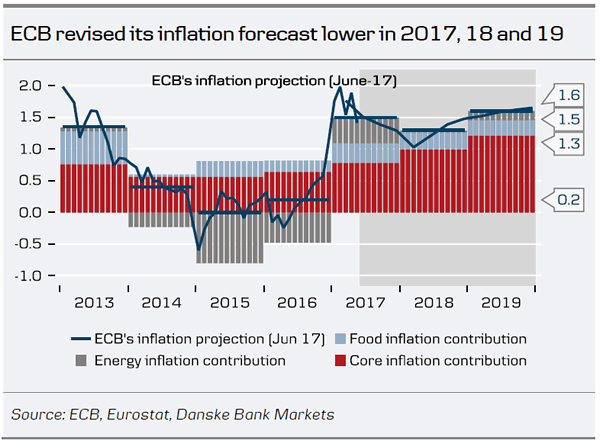
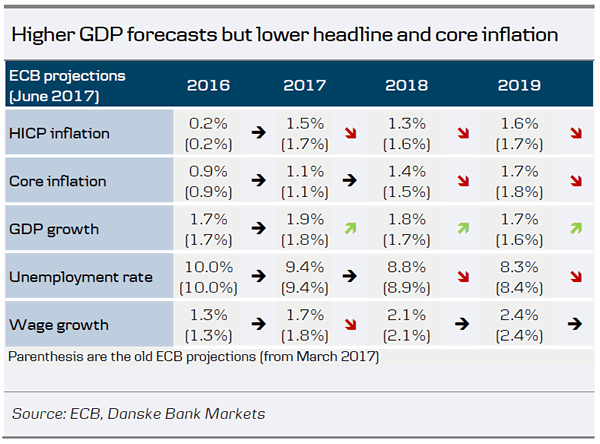
Fixed income: No prelude to a major sell-off
We do not see today’s ECB meeting as a prelude to a major sell-off in the European fixed income market despite the removal of "or lower" from the introductory statement and the upward revisions to the growth forecasts. In fact, neither should come as a major surprise to the market given the ongoing economic recovery and the reduced risk of outright deflation. For the fixed income market it is pivotal that the change to the introductory statement was mainly due to the improved economic outlook and not an improved inflation outlook given the significant downward revisions to the 2018 inflation outlook in particular. We also note that Draghi mentioned that the ECB still expects very muted wage growth in the euro area. In our view Draghi today managed to convince the market that inflation is still ‘the only’ mandate for the ECB.
Hence, we do not expect today’s meeting to change the outlook for EUR rates and yields for 2017. We argue that there are several supportive factors for the European bond market for the next six months. We discuss that in detail in Strategy: Low yield environment intact, published on 1 June 2017.
We generally recommend positioning for further performance for periphery bond markets and to take advantage of the relatively steep curves in the 5Y segment in the periphery bond markets. Today’s strong performance by periphery markets underlines that the market is increasingly betting on an extension of the PSPP programme into 2018. For more, see the latest issue of Government Bonds Weekly that we published 2 June.
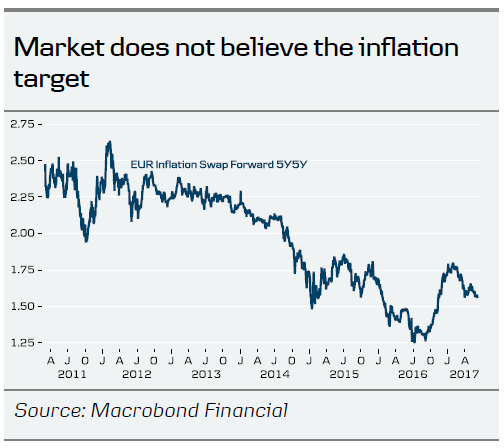
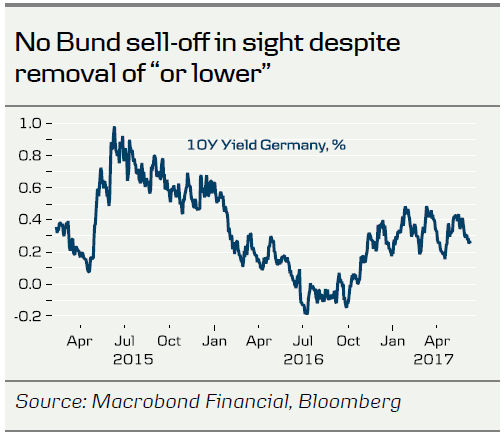
FX: too early for ECB to unlock upside EUR potential
It was down and back again for EUR/USD following today’s meeting with the cross briefly dipping below 1.12 but now back in the 1.1220 area. The hawkish amendments in the statement were indeed balanced by the significant downward revisions to inflation, suggesting to the FX market that rate hikes are still very far off as indeed the postponement of a first hike hints. We have previously stressed the importance of rates communication for the euro, i.e. the ‘reverse hot potato’ effect coming into play with the possibility of sending EUR crosses higher on a sustained basis. However, today’s message from the ECB is not in our view going to be a key catalyst for further EUR/USD upside for three reasons.
First, ECB rate hikes will be deemed far away by the market as long as euro area inflation struggles to tick higher – and a first rate hike needs to be eyed in order for the upside potential in notably EUR/USD from fundamental factors to be unlocked on a larger scale in our view (our medium-term fundamental estimate is 1.26). This should be a story for late H2. Second, speculative positioning has turned net long the single currency and likely some longs were liquidated today, driving part of the initial drop in EUR/USD. If cyclical momentum in the eurozone wears off in the coming months the risk is that sentiment could reverse somewhat and fuel EUR selling again. Third, a Fed that will likely at the meeting next week confirm its determinedness to move on with hikes and balance-sheet reduction down the road could lead markets to reassess the rather soft pricing of the fed funds rate currently in place. As a result, USD strength could return temporarily in the summer.
We remain tactically short EUR/USD in the Danske FX Trading Portfolio – see Danske FX Trading Portfolio: Sell EUR/USD for short-term dip on June reality check – and maintain our call for a summer dip in the cross. We continue to project an uptick in the pair in 6-12M targeting 1.16 in one year’s time. The result of the UK general election today will be the next focal point for FX markets but is unlikely to have much impact on EUR/USD.
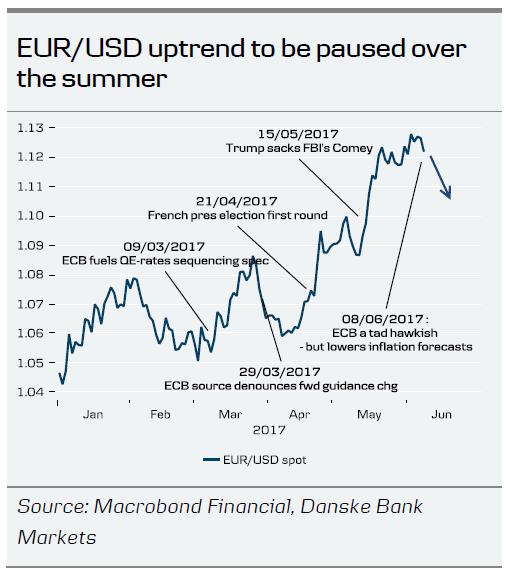
ECB’s updated projections
The ECB lowered its headline inflation projections considerably for 2018 and slightly for 2019. The revision was mainly due to the oil price, but the core projection was also lowered.


The ECB kept its 2017 core inflation forecast unchanged but lowered it by 0.1pp in 2018 and 2019. Despite the modest revision, the ECB’s projection is still too optimistic in our view.
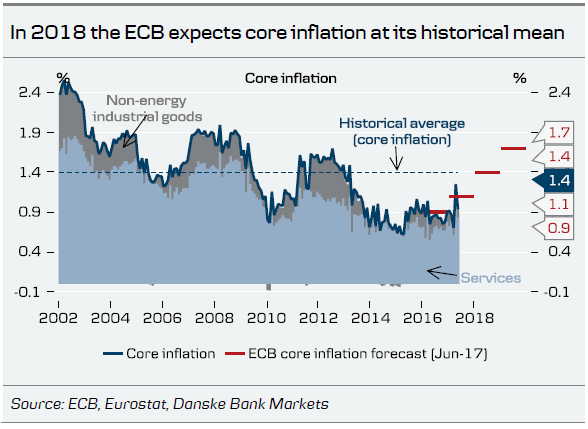
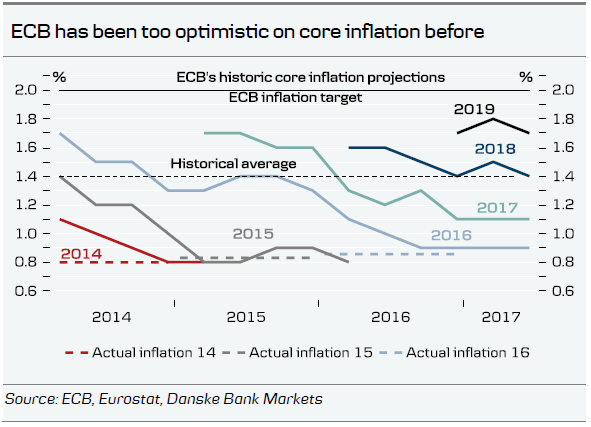
The ECB did not change its wage forecast for 2018 and 2019 and in our view, the projection remains hopeful. Without rising wages it will be very difficult to see higher underlying prices.
